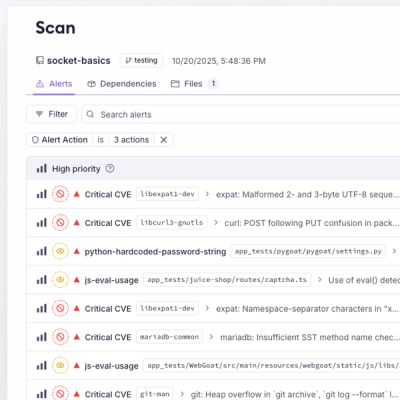
Research
Malicious NuGet Packages Typosquat Nethereum to Exfiltrate Wallet Keys
The Socket Threat Research Team uncovered malicious NuGet packages typosquatting the popular Nethereum project to steal wallet keys.
@gemini-testing/react-lazyload
Advanced tools
Lazyload your components, images or anything where performance matters.
This project is now currently maintained by @ameerthehacker, please reach out to him on any issues or help.

Lazyload your Components, Images or anything matters the performance.
one-time lazy load and continuous lazy load modescroll / resize event handler is throttled so you won't suffer frequent update, you can switch to debounce mode too2.0.0 is finally out, read Upgrade Guide, it's almost painless to upgrade!
$ npm install --save react-lazyload
import React from 'react';
import ReactDOM from 'react-dom';
import LazyLoad from 'react-lazyload';
import MyComponent from './MyComponent';
const App = () => {
return (
<div className="list">
<LazyLoad height={200}>
<img src="tiger.jpg" /> /*
Lazy loading images is supported out of box,
no extra config needed, set `height` for better
experience
*/
</LazyLoad>
<LazyLoad height={200} once >
/* Once this component is loaded, LazyLoad will
not care about it anymore, set this to `true`
if you're concerned about improving performance */
<MyComponent />
</LazyLoad>
<LazyLoad height={200} offset={100}>
/* This component will be loaded when it's top
edge is 100px from viewport. It's useful to
make user ignorant about lazy load effect. */
<MyComponent />
</LazyLoad>
<LazyLoad>
<MyComponent />
</LazyLoad>
</div>
);
};
ReactDOM.render(<App />, document.body);
If you want to have your component lazyloaded by default, try this handy decorator:
import { lazyload } from 'react-lazyload';
@lazyload({
height: 200,
once: true,
offset: 100
})
class MyComponent extends React.Component {
render() {
return <div>this component is lazyloaded by default!</div>;
}
}
You should be aware that your component will only be mounted when it's visible in viewport, before that a placeholder will be rendered.
So you can safely send request in your component's componentDidMount without worrying about performance loss or add some pretty entering effects, see this demo for more detail.
Type: Node Default: undefined
NOTICE Only one child is allowed to be passed.
Type: Number/String Default: undefined
In the first round of render, LazyLoad will render a placeholder for your component if no placeholder is provided and measure if this component is visible. Set height properly will make LazyLoad calculate more precisely. The value can be number or string like '100%'. You can also use css to set the height of the placeholder instead of using height.
Type: Bool Default: false
Once the lazy loaded component is loaded, do not detect scroll/resize event anymore. Useful for images or simple components.
Type: Number/Array(Number) Default: 0
Say if you want to preload a component even if it's 100px below the viewport (user have to scroll 100px more to see this component), you can set offset props to 100. On the other hand, if you want to delay loading a component even if it's top edge has already appeared at viewport, set offset to negative number.
If you provide this props with array like [200, 200], it will set top edge offset and bottom edge offset respectively.
Type: Bool Default: true
Listen and react to scroll event.
Type: Bool Default: false
Respond to resize event, set it to true if you do need LazyLoad listen resize event.
NOTICE If you tend to support legacy IE, set this props carefully, refer to this question for further reading.
Type: Bool Default: false
If lazy loading components inside a overflow container, set this to true. Also make sure a position property other than static has been set to your overflow container.
Type: Any Default: undefined
Specify a placeholder for your lazy loaded component.
If you provide your own placeholder, do remember add appropriate height or minHeight to your placeholder element for better lazyload performance.
Type: Bool Default: false
The lazy loaded component is unmounted and replaced by the placeholder when it is no longer visible in the viewport.
Type: Bool / Number Default: undefined
Lazyload will try to use passive event by default to improve scroll/resize event handler's performance. If you prefer control this behaviour by yourself, you can set debounce or throttle to enable built in delay feature.
If you provide a number, that will be how many ms to wait; if you provide true, the wait time defaults to 300ms.
NOTICE Set debounce / throttle to all lazy loaded components unanimously, if you don't, the first occurrence is respected.
DEPRECATED NOTICE
This props is not supported anymore, try set overflow for lazy loading in overflow containers.
It is available to manually trigger checking for elements in viewport. Helpful when LazyLoad components enter the viewport without resize or scroll events, e.g. when the components' container was hidden then become visible.
Import forceCheck:
import { forceCheck } from 'react-lazyload';
Then call the function:
forceCheck();
$ npm run demo:watch
$ npm run build
Let's say there is a fixed date picker on the page, when user picks a different date, all components displaying data should send ajax requests with new date parameter to retreive updated data, even many of them aren't visible in viewport. This makes server load furious when there are too many requests in one time.
Using LazyLoad component will help ease this situation by only updating components visible in viewport.
MIT
FAQs
Lazyload your components, images or anything where performance matters.
The npm package @gemini-testing/react-lazyload receives a total of 0 weekly downloads. As such, @gemini-testing/react-lazyload popularity was classified as not popular.
We found that @gemini-testing/react-lazyload demonstrated a not healthy version release cadence and project activity because the last version was released a year ago. It has 5 open source maintainers collaborating on the project.
Did you know?

Socket for GitHub automatically highlights issues in each pull request and monitors the health of all your open source dependencies. Discover the contents of your packages and block harmful activity before you install or update your dependencies.

Research
The Socket Threat Research Team uncovered malicious NuGet packages typosquatting the popular Nethereum project to steal wallet keys.

Product
A single platform for static analysis, secrets detection, container scanning, and CVE checks—built on trusted open source tools, ready to run out of the box.

Product
Socket is launching experimental protection for the Hugging Face ecosystem, scanning for malware and malicious payload injections inside model files to prevent silent AI supply chain attacks.